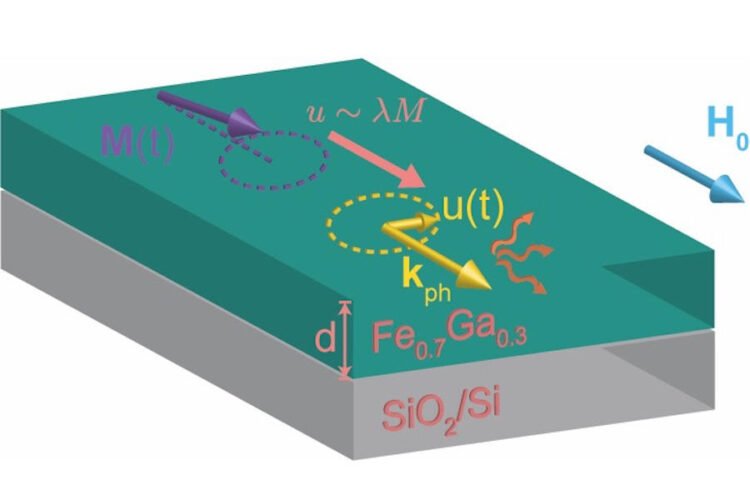Researchers discover a key cause of energy loss in spintronic materials

University of Minnesota-led research discovered that the interaction between magnetism and sound particles in spintronic devices can lead to damping, or the loss of energy, a process depicted in the figure above. The finding will ultimately allow engineers to develop more efficient spintronic devices in the future. Photo credit: Bill Peria, University of Minnesota
Study could help engineers build more efficient magnetic materials for computers.
A study led by University of Minnesota Twin Cities researchers uncovered a property of magnetic materials that will allow engineers to develop more efficient spintronic devices in the future. Spintronics focuses on using the magnetic “spin” property of electrons instead of their charge, which improves the speed and efficiency of devices used for computing and data storage.
The research is published in Physical Review B, a peer-reviewed scientific journal published by the American Physical Society.
One of the major roadblocks in developing better spintronic devices is an effect called “damping,” in which the magnetic energy essentially leaks out of the materials, causing them to be less efficient. Traditionally, scientists have blamed this property on the interaction between the spin of the electron and its motion. However, the University of Minnesota-led team has proven that there is another factor–magnetoelastic coupling, which is the interaction between electron spin, or magnetism, and sound particles.
“Our work doesn’t say that [the original theory] is wrong, it just says that that’s only part of the story,” explained Bill Peria, lead author of the study and a Ph.D. student in the University of Minnesota’s School of Physics and Astronomy. “We were able to show that in these magnetic materials, we do see that behavior, but it’s actually only a relatively minor fraction of the entire damping. There’s also this other mechanism by which the magnetism can be damped that is not usually considered.”
The researchers used a technique called ferromagnetic resonance, which measures how much magnetic energy is released or leaked. In order to understand the phenomenon, they had to perform this technique at multiple temperatures, ranging from room temperature to 5 Kelvin, just five degrees above absolute zero and the equivalent of about -450 degrees Fahrenheit.
The study’s findings provide a more holistic picture of what causes damping. This will allow engineers to develop magnetic materials with “ultralow” damping that are more energy efficient, ultimately leading to higher quality computers of the future.
“We care about low damping because we, along with our collaborators, are trying to make devices in which magnetic excitations can propagate over long distances,” said Paul Crowell, senior author of the paper and a professor in the University’s School of Physics and Astronomy. “We are trying to build the ‘wires’ in which magnetic signals can propagate across a chip without losing their strength.”
###
In addition to Peria and Crowell, the research team included University of Maryland researchers Ichiro Takeuchi (professor), Xinjun Wang (postdoctoral researcher), and Heshan Yu (Ph.D. student); and Seunghun Lee, a professor of physics at Pukyong National University in Busan, South Korea.
The research was supported by the University of Minnesota’s Spintronic Materials for Advanced Information Technologies (SMART) center, which is funded by nCORE, a Semiconductor Research Corporation program sponsored by the National Institute of Standards and Technology.
All latest news from the category: Physics and Astronomy
This area deals with the fundamental laws and building blocks of nature and how they interact, the properties and the behavior of matter, and research into space and time and their structures.
innovations-report provides in-depth reports and articles on subjects such as astrophysics, laser technologies, nuclear, quantum, particle and solid-state physics, nanotechnologies, planetary research and findings (Mars, Venus) and developments related to the Hubble Telescope.
Newest articles

High-energy-density aqueous battery based on halogen multi-electron transfer
Traditional non-aqueous lithium-ion batteries have a high energy density, but their safety is compromised due to the flammable organic electrolytes they utilize. Aqueous batteries use water as the solvent for…

First-ever combined heart pump and pig kidney transplant
…gives new hope to patient with terminal illness. Surgeons at NYU Langone Health performed the first-ever combined mechanical heart pump and gene-edited pig kidney transplant surgery in a 54-year-old woman…

Biophysics: Testing how well biomarkers work
LMU researchers have developed a method to determine how reliably target proteins can be labeled using super-resolution fluorescence microscopy. Modern microscopy techniques make it possible to examine the inner workings…





















